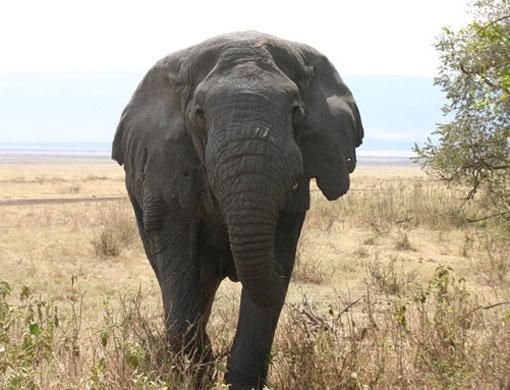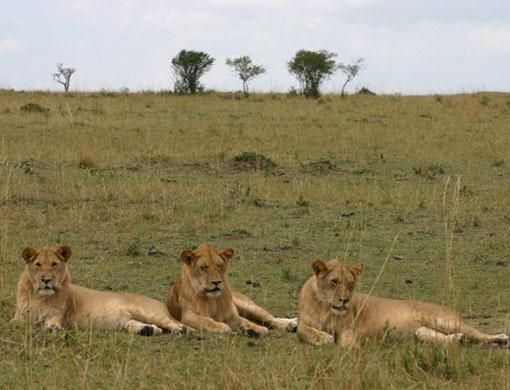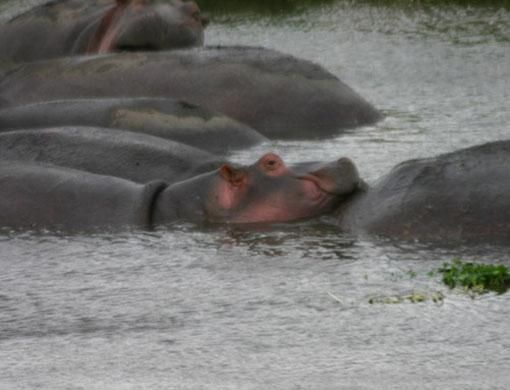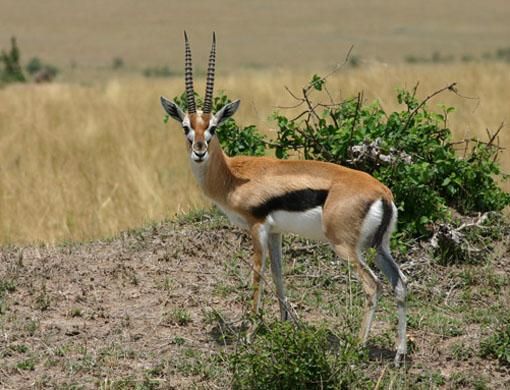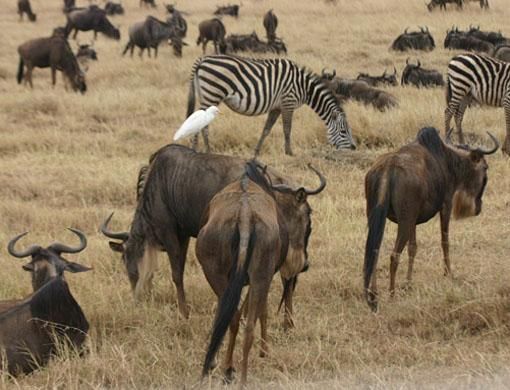“Hold on tight and don't let go!'' shouted Samson over the sound of the motor as the van rumbled down the rough, weather-beaten path towards the cavernous mouth of the Ngorongoro crater.
My mouth went dry and my hands turned clammy in anticipation of what lay only a few kilometres ahead.
Our tiny safari party was soon swallowed up by the yawning jaws of the crater.
Flourishing within the belly and the walls of this natural amphitheatre were approximately 25,000 wild animals roaming free.
To me, that felt like unearthing the proverbial pot of gold at the rainbow's end.
One of the highest peaks
Between steering the van down the rugged dirt route and listening to his blaring radio, Samson, my Tanzanian guide, enlightened me about this Unesco World Heritage Site.
About three million years ago, Ngorongoro was one of the highest peaks in Africa.
Triggered by the turbulent formation of the Rift Valley, the volcano erupted and then collapsed on itself forming the dramatic Ngorongoro crater, measuring 265 square kilometres, now known as the Ngorongoro Conservation Area.
I looked out at the clear blue Tanzanian sky from the van window and imagined the volcano spewing lava in fury and transforming the scene forever.
Home to the big five
This indentation on the African plains, rich in fertile volcanic soil, became home to Africa's “big five'' — the rhinoceros, lion, leopard, elephant and buffalo.
A combination of lakes, swampy grasslands and lush green forests attracted an assortment of air- and land-bound fauna to feed, soak, forage and wander freely.
Spread out on a yellow, sun-baked carpet of savannah grass lay wildebeest and zebras in their thousands.
Shoulder to shoulder they stood, grazing peacefully while I feasted my eyes on them.
Towering Euphorbia trees dotted the 600-metre-deep crater. Heat waves emanated from the ground as these grassy plains sweltered under the blazing African sun.
Gazelles, buffalo, eland, wildebeest and zebra roam the very same savannah as their large carnivore neighbours.
Breaking my reverie, Samson's two-way radio crackled to life with news of lion sightings.
My heart pounded as our coffee-coloured vehicle tore through the grass, kicking up dirt in its wake.
Unmatched prowess
Three young males, possibly brothers, were spotted on a hillside.
In their prime, these cubs with developing golden manes were clearly biding their time to adulthood.
Eventually they would fight an older male and take over his pride.
This would ensure the right to mate with the pride's lionesses and sire the next generation.
For the moment, these gorgeous, golden kings with young manes to match looked perfectly content.
Lions are stealthy killing machines with powerfully built torsos and crushing jaws to bring down prey double their size and to rip it to shreds. It is plain to see why it is considered the king of beasts.
Samson decided it was time for a break and scouted around for a comfortable picnic.
Sitting under the cool shade of an ancient baobab tree, the spot selected could not have been better.
With sprawling grasslands for view and twittering birds for company, we gobbled up sandwiches, washing them down with cans of chilled juice.
As the van set off one more time, I took my place under the open roof once again, drowsy from the warmth and the picnic but too excited to miss out anything.
And then I saw them — two graceful ostriches — one male, one female.
Black-and-white plumes puffed up, the male ostrich attempted a mating dance, enthusiastically bobbing his head about.
Hearing the crackle of twigs, Samson killed the noisy ignition. Rustling through the grass was a lone bull elephant.
He cut through the grassy path a few metres ahead of our grimy van. Solitary in his thoughts, the elephant explored his environs and chewed on leaves.
It is never a good idea to get too close to a bull elephant, so Samson quickly started the engine and gently backed away.
As we moved from the bush into the open grasslands, we came across Maasai tribesmen dressed in red, casting long shadows in the late afternoon sun.
Tall, dark and handsome, they carried long sticks and grazed their cattle on a hillside.
Arriving in the region somewhere in the 1800s, they were moved in 1959 to the newly declared Ngorongoro Conservation Area.
The Maasai tribespeople are permitted to graze their cattle in this crater, thereby maintaining their way of life within a natural environment.
Charred earth
I looked out the back of the van to see shimmering images of our crimson-clad friends disappear in the afternoon haze.
Blackened earth under our wheels seemed to taint the terrain. Samson explained that to manage vegetation in the crater, grass and bush were often set on fire.
Dusk settled and the buzz of insects infused the air as a turmeric sun set over the majestic Tanzanian terrain.
Like members of a privileged audience, I had been witness to an exceptional display of Africa's natural performers.
Twilight would bring its own share of sinewy shadows, stalking the savannah and its swampy watering holes.
Standing up through the open roof, I turned towards the auburn expanse to see the sky and earth become one — the fierce eternal bond that brings together the grassland with grazers, dry bush with strapping tribesmen, and forests with foragers. A never-ending circle of life.
— Andrea Bailey is a UAE-based freelance writer
Go there ... From the UAE ... From Dubai
Dar es Salaam is the closest international airport to the Ngorongo Crater.
Emirates flies daily. Fare from Dh2,520
Kenya Airlines flies daily. Fare from Dh2,520
— Information courtesy: The Holiday Lounge by Dnata.
Tel: 04 4298576
Getting there from Dubai
- Ngorongoro is a 190-kilometre drive from Arusha. Safari holidays can be booked in advance from Dubai.
Ngorongoro climate and best time to travel: - Waking up to cool morning mists in most months, the high altitudes seem to bring a crispy clean quality to the air.
The weather is generally dry from June through November. Ngorongoro receives rainfall from November to May. It rains more during April and May. July is the coldest month. - High season: January, February, July, August, October.
- Mid season: March, June, September, November and December.
- Low season: April and May.
Where to stay - Ngorongoro Sopa Lodge: Situated on the crater rim, the overall look of this lodge is lavish and nostalgic.
- Ngorongoro Crater lodge: This ultra-romantic lodge is divided into three distinct camps.
Service is personal; dinner is a romantic affair under the stars and views from bath chambers is magnificent. - Ngorongoro Serena Safari Lodge: Packed with cosy rooms laid out on two levels, this lodge is decorated with cave-style illustrations, creating an interesting atmosphere.
- Gibb's farm: Set in the highlands, this old colonial farmhouse comes complete with bungalow rooms and a charming old English country garden.
The surrounding gardens are rich with fruits, home-grown vegetables and flowers. - Plantation Lodge, Ngorongoro highlands: This 16-room hotel is situated in the highlands and not at the crater rim.
- The Plantation Lodge is brimming with old-world charm. It is hidden away from civilisation and is cocooned by coffee plantations.
- Ngorongoro Wildlife Lodge: This former government hotel from the 1970s lies on the rim of the Ngorongoro crater and has a superb location overlooking the crater floor.
The lounge is attractive with its big stone fireplace and African decor and furnishings.
Deceptive looks
Though dust penetrated my clothes and settled on my skin, the sheer joy of spotting wildlife far outweighed this minor irritant.
The van swerved sharply and water spilled from my flask as I tried to take a sip.
I looked up in time to spot several muddy mounds in a swamp.
A family of mud-encrusted hippos was wallowing lazily, grunting occasionally and generally looking bored.
Ah ... the dreariness of daily mud baths, constant night-time feedings and relaxing pool lounges must take its toll!
Samson divulged that hippos prevent getting sunburnt by staying submerged all day long, only leaving the watering hole at nightfall.
Hippos have a bad temper. Of all African wild animals, they are the ones responsible for most human deaths — something that I found very difficult to imagine.
That particular morning they looked more lethargic than lethal but I didn't have the nerve to challenge years of research.


